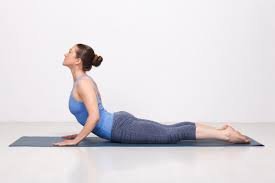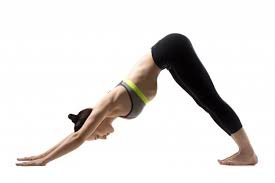Modern life science has studied the consequences of Surya namaskar and yogic techniques. In yoga, the sun is represented by Surya Nadi, which carries the vital life-giving force. Surya namaskar is an ancient method of worshiping the Sun. In Sanskrit literature Surya means sun, and the word namaskar means salutation.
What is Surya Namaskar?
Surya Namaskar is a set of 12 Asanas. The heart, liver, intestine, stomach, chest, throat, legs, and backbone are the most benefited organs. The regular practice of Surya Namaskar improves blood circulation throughout the body, maintains health, and makes the body disease-free, giving strength, flexibility, and vitality to the body.
Sun Salutation asanas help to burn extra body fat on the belly, buttocks, and back by modulating the endocrine system. It helps to manage menstrual cycles among women and also facilitates easy childbirth. Surya Namaskar also helps to stay the mind stress-free, calm, and relaxed. It balances the entire endocrine system by direct massaging of glands and by increasing blood flow. The practitioner can feel an additional supercharge of energy in his body after doing it regularly. Surya Namaskara gives peace to the mind and reduces emotional stress. In this way, the Surya Namaskara also can give us many subtle benefits beyond the physical.
Asana – Chakra Position
1. Pranamasana – Anahata (Heart)
2. Hasta Uttanasana – Vishuddhi (Throat)
3. Hastapadasana – Swadhisthana (Sacrum)
4. Ashwa Sanchalanasana – Ajna (Third eye)
5. Adho Mukha Svanasana / Parvatasana – Vishuddhi (Throat)
6. Ashtanga Namaskara – Manipur (Solar plexus)
7. Bhujangasana – Swadhisthana (Sacrum)
8. Adho Mukha Svanasana/ Parvatasana – Vishuddhi (Throat)
9. Ashwa Sanchalanasana – Ajna (Third eye)
10. Hastapadasana – Swadhisthana (Sacrum)
11. Hasta Uttanasana- Vishuddhi (Throat)
12. Pranamasana – Anahata (Heart)
Asana (Postures) of Surya Namaskar:
Surya Namaskar is a group of 12 Asanas (postures), it’s done preferably within the morning while facing the rising sun. These postures encompass periodic forward and backward bending alongside deep exhalation and inhalation respectively to the utmost possible extent.
Pranamasana (Prayer pose):
Pranamasana or the Prayer Pose is the 1st and 12th pose for Surya Namaskara. In Sanskrit, the word Pranam means ‘to pay respect’; so it refers to this asana as Pranamasana.
Method: Stand erect with folded hands on the brink of the chest and palms are held together within the sort of prayer pose. Look straight ahead, Exhale, then breathe normally.
Benefits: It creates a way of relaxation, calmness, and concentration within the mind at the beginning of the Surya Namaskara.

Hasta Uttanasana (Raised arms pose):
Hasta Uttanasana or the raised arms pose is the 2nd and the 11th pose.
Method: Raise both hands uprising the crown from Pranamasana pose. Inhale the breath normally while raising your hands. Bend the trunk and neck slightly backward.
Benefits: It improves the digestive process; It strengthens and tones the abdominal and chest musculature. It supports the respiratory system.

Hastapadasana (Hand to Foot pose):
Hastapadasana or the Hand to Foot pose is the 3rd and 10th pose.
Method: Bend forward from Hasta Uttanasana pose and touch the ground with both hands. Exhales breathe normally while bending forward.
Benefits: Hastapadasana makes the body flexible, helps to decrease excess abdominal fat, and really beneficial for the gastrointestinal and nervous system.

Ashwa Sanchalanasana (The Equestrian Pose):
Ashwa Sanchalanasana or the Equestrian pose is the 4th and the 9th pose.
Method: Stretch the left leg back as far as possible from Hastapadasana pose while inhaling the breath normally. At an equivalent time, bend the proper knee. While looking straight ahead, the hands should be kept straight with fingers touching the ground. Arch the rear a touch with the head tilted back. The equivalent step should be repeated with the left knee within the second round of Surya Namaskara.
Benefits: Ashwa Sanchalanasana tones the abdominal organs, It gives flexibility to the body and balances the central nervous system.

Dandasana (The Stick Pose):
Dandasana is also known as Stick Pose or Plank Pose. It is the 5th pose. A vital component of the act of Dandasana is to develop familiarity with the spine’s arrangement, from the tailbone right to the crown of the head.
Method: Attempt to bring the calf and thigh of the correct leg near one another. Hold the breath, bring the correct leg back, consolidate the feet, keeping the arms, legs, and back straight in Plank Pose. Your feet ought to stay erect.
Benefits: Dandasana fortifies all significant center muscles, improves stance, and expands endurance!

Ashtanga Namaskara (Eight-Limb salutation):
Ashtanga Namaskara or the Eight-Limbed salutation is the 6th pose. During this pose, the body touches the bottom in eight locations–the head, the chest, the 2 palms, the 2 knees, and therefore the two toes. In Sanskrit grammar, ashta means eight, and anga means part. Hence this asana Ashtanga Namaskara.
Method: Lower the body to the bottom from Parvatasana pose in such a way that it touches the ground at eight locations-the top, the chest, the 2 palms, the 2 knees, and therefore the two toes, Suspend the breath for a short time. Attempt to lift other parts within the air.
Benefits: It strengthens the muscles of both upper and lower limbs and strengthens the respiratory system.

Bhujangasana (The Cobra Pose):
Bhujangasana is known as a cobra pose in yoga. The meaning of Bhujanga in Sanskrit means ‘cobra’ snake pose. During this asana a person’s head and trunk resemble a cobra with a raised hood, hence the name Bhujangasana. It’s a serious backward bending asanas used in yoga. It appears because of the 7th pose within the Surya Namaskara series asanas.
Method: While inhaling, raise the body by using the hands from the Ashtanga Namaskara pose. Arch your head backward. This position seems like the cobra which has raised its hood.
Benefits: Bhujangasana strengthen the entire muscular back, especially the lower back. It improves the flexibility of the spine and surrounding muscles, good for the gastrointestinal, reproductive, and urogenital apparatus.

Parvatasana (The Mountain Pose):
Parvatasana or the Mountain pose is the 8th pose. In Sanskrit terminology, Parvata means mountain, and this pose seems like a mountain, so it’s referred to as Parvatasana.
Method: While exhaling, take the proper leg backward from Ashwa Sanchalanasana pose and place it parallel to the left leg, raise the buttocks at an equivalent time. Place the hands straight, supporting the load of the body. The top should be placed between the hands.
Benefits: Parvatasana strengthens the muscles of both upper and lower limbs, maintains the blood circulation to the Central nervous system, and tones the peripheral nervous system.

Benefits of Surya Namaskar:
The advantages of Surya Namaskar are complex. It helps in better working of the body and intellectual capacities. Here are a couple of advantages of Surya Namaskar:
- The stances are a correct mix of warm-ups and asanas.
- It assists with keeping you illness free and solid.
- Standard practice advances balance in the body.
- Improves blood dissemination.
- Reinforces the heart.
- Tones the stomach related lot.
- Invigorates muscular strength, respiratory framework, lymphatic framework, spinal nerves and other interior organs.
- Tones the spine, neck, shoulder, arms, hands, wrist, back and leg muscles, in this way advancing general adaptability.
- Mentally, it controls the interconnectedness of body, breath, and brain, hence making you more quiet and boosting the energy levels with honed mindfulness
- Surya Namaskar is additionally enormously helpful for getting thinner, skincare, and hair care.
Benefits of Surya Namaskar for Weight Loss:
- It is a serious actual exercise that deals with all aspects of the body.
- You can expand the quantity of rounds gradually and watch the pounds vanish. The twists and stretches assist you with losing fat equitably.
Benefits of Surya Namaskar for hair:
- Surya Namaskar improves blood flow to the scalp, in this way forestalling balding.
- The expanded blood flow sustains the head and empowers sound hair development.
- Various postures help forestall the turning gray of hair.
Benefits of Surya Namaskar for Sparkling Skin:
- Surya Namaskar improves blood course to all pieces of the body, in this way keeping the skin youthful.
- It expands energy and essentialness, in this manner making your face sparkle with brilliance. This assists the skin in withholding its solidness.
- Surya Namaskar forestalls the beginning of wrinkles by diminishing the body and brain of pressure.
“Sun Salutation can energize and warm you, even on the darkest, coldest winter day.”– Carol Krucoff.

